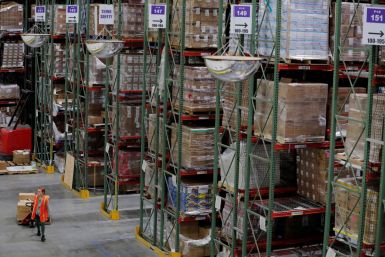Expectations of more Federal Reserve tightening and economic worries are weighing on a rebound in consumer discretionary stocks, though some investors believe the sector will outperform other areas of the market if growth begins to wobble in coming months.
Japan will not intervene to stem the yen's decline, said just over half of economists polled by Reuters, though a fifth said weakening beyond 150 per U.S.
The Bank of Japan's dovish deputy governor Masayoshi Amamiya ranked top among candidates to become the bank's next head in a Reuters poll of economists, a sign he remains the market's favourite to succeed incumbent Governor Haruhiko Kuroda.
India's government is in no hurry to push inflation - now hovering near 7% and eight-year highs - back to the central bank's 4% medium-term target, for fear that aggressive rate hikes could hurt economic growth, two sources with direct knowledge of the matter said.
In the last five months, the greenback has gained roughly 10% against the yuan due to a combination of monetary tightening in the U.S. and monetary loosening up in China.
Oil prices slid on Wednesday, extending the previous day's losses, as investors braced for another aggressive interest rate hike from the U.S.
A top European industry group warned on Wednesday that firms were losing confidence in China and that its standing as an investment destination was being eroded, citing its "inflexible and inconsistently implemented" COVID policy as a key factor.
Europe's problems in sourcing oil and gas this winter after a dispute with Russia may be exacerbated by a new crisis in the market where prices are already red-hot: a liquidity crunch that could send them spiralling higher still.
Inflation in Canada remains "too high" but is headed in the right direction, a Bank of Canada official said on Tuesday, adding that the central bank will do whatever is needed to bring price increases back to target.
JPMorgan Chase & Co Chief Executive Jamie Dimon plans to tell Congress that the U.S. economy faces "storm clouds," according to prepared testimony.
Wall Street's main indexes were set to open lower on Tuesday as investors positioned themselves for new economic projections and another large interest rate hike by the Federal Reserve this week to quell decades-high inflation.
The latest turmoil in major sovereign debt markets is far from over as bond strategists in a Reuters poll expected yields to stay elevated well into next year, with risks firmly skewed towards their moving higher than currently predicted.
Sweden's central bank raised interest rates on Tuesday by a larger-than-expected full percentage point to 1.75% and warned of more to come over the next six months as it sought to get to grips with surging inflation.
Japan's ruling party is ramping up calls for a fresh spending package worth at least $105 billion to cushion the blow from rising inflation, reinforcing fears that the world's third largest economy will lag others in pruning huge fiscal support.
The dollar remained firm below a two-decade high versus major peers on Tuesday, as investors braced for the Federal Reserve to continue its aggressive interest-rate-hiking campaign to rein in overheated inflation.
Oil prices were little changed on Tuesday, after rising in the previous session, on concerns that interest rate hikes in the United States to tame inflation will curb economic growth and fuel demand in the world's biggest crude consumer.
Bank Indonesia will follow a surprise August interest rate rise with another 25 basis point hike at its meeting on Thursday, still moving more slowly than most of its peers in trying to bring down inflation, a Reuters poll forecasts.
Turkish lenders Isbank and Denizbank have suspended use of Russian payment system Mir, the banks said on Monday, following a U.S.
The world's central bank umbrella body, the Bank for International Settlements (BIS), has urged major economies to forge ahead with forceful interest rate hikes despite the growing threat of recessions and currency market volatility.
Wall Street's main indexes were set for a lower open on Monday, extending declines for a third straight day as investors worried that another massive interest rate hike by the Federal Reserve could tip the U.S.
Top lender State Bank of India has asked exporters to avoid settling deals with Bangladesh in the dollar and other major currencies as it looks to curb exposure to Dhaka's falling reserves, according to an internal document and a source.
Oil prices climbed on Monday as a weaker dollar and supply concerns ahead of the European Union embargo on Russian oil in December offset fears of a global recession that could dampen fuel demand.
The dollar held about 1% below a two-decade peak versus major peers at the start of a week that sees some dozen central bank decisions, headlined by the Federal Reserve on Wednesday and followed by the Bank of Japan and Bank of England the next day.
Share markets idled in Asia on Monday as investors braced for a week littered with 13 central bank meetings that are certain to see borrowing costs rise across the globe and some risk of a super-sized hike in the United States.
Before the pandemic, Doris Fu imagined a different future for herself and her family: new car, bigger apartment, fine dining on weekends and holidays on tropical islands.
Pakistan will "absolutely not" default on debt obligations despite catastrophic floods, the finance minister said on Sunday, signalling there would be no major deviation from reforms designed to stabilise a struggling economy.
The European Central Bank could raise interest rates into next year, causing pain for consumers as it tries to depress demand that is now increasingly adding to sky high inflation, chief economist Philip Lane said on Saturday.
With sharp increases in the price of homes, fuel and food, certain markets in the United States have been hit the hardest when it comes to inflation.
A tough year in markets is leading some investors to seek refuge in cash, as they capitalize on higher interest rates and await chances to buy stocks and bonds at cheaper prices.
The Canadian dollar weakened to its lowest level in nearly two years against the greenback on Friday and Canada's stock market fell more than 1% as investors grew cautious ahead of domestic inflation data and a Federal Reserve interest rate decision next week.



















































